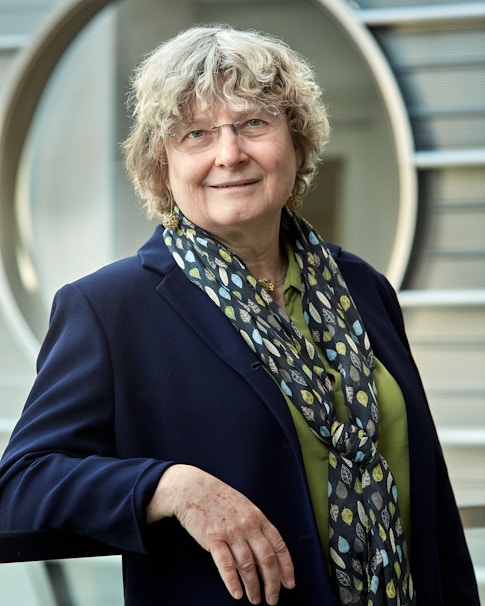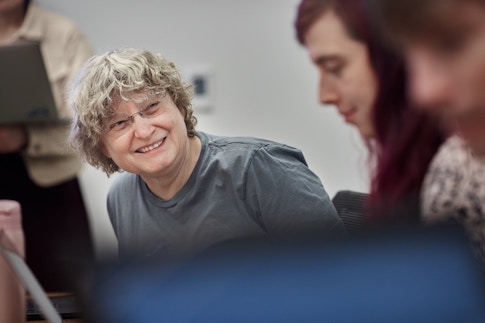Making Wavelets: A Profile of Ingrid Daubechies

Ingrid Daubechies’ garden at her home near Duke University is an explosion of blackberry bushes, clover, hellebore, columbine, blueberries, jasmine, many kinds of irises, and even pawpaw, a lesser-known fruit native to the eastern U.S. As she meanders along her carefully laid-out mulch and stone paths — a nice change from her default pace of a quick trot that can leave walking companions a bit out of breath — she can’t help working on the garden and musing on its success.
“My soil is very good, so I constantly get things that want to grow here,” Daubechies explains while pulling weeds and thinning out a clump of purple bearded irises. “It’s just the result of putting in organic stuff all the time, and the soil becomes very good.”
Daubechies’ sprawling and spectacular garden is an apt metaphor for her professional legacy: Wide-ranging tools and mathematical objects have taken root in a variety of fields under her watchful eye. Although a physicist and applied mathematician by training, Daubechies has published more than 150 papers touching on areas including art restoration, evolutionary biology, electrical engineering and, most famously, image and data processing.
“To do something really innovative in mathematics, you have to think a little bit differently than other people about a given problem,” says Ron DeVore, a Texas A&M mathematician and Daubechies’ frequent collaborator over the past two decades. “That’s something she brings to the table. She has fresh viewpoints about different subjects, and that can shake things up.”
Daubechies is best known for her work on mathematical structures called wavelets, which are critical to the field of signal processing. Traditionally, the field relied on Fourier analysis, which represents signals as infinite series of sinusoidal functions to analyze phenomena that gradually vary over time or space, such as sound or radio waves. Adding up those infinite series takes time, so Fourier analysis can be inefficient at processing signals, especially those that have sharp, sudden changes, such as images.
For such abrupt signals, however, wavelets are ideal. They resemble a single pulse on a heartbeat monitor: a spiky wavelike function that vanishes to zero outside a predefined domain, unlike sine waves, which go on to infinity. Instead of having to add up infinite Fourier series for more complicated signals, researchers can consider only wavelets that are nonzero at a given point.
This approach dramatically cuts processing time. For example, instead of assigning every pixel in a gray-scale image a color value between 0 (black) and 255 (white), engineers could assign a few well-constructed wavelets to mark the boundary of large blocks that have the same gray level, thereby decreasing the data used to encode the image.
But until Daubechies tackled the problem, researchers didn’t even know if such well-constructed functions existed, much less how to express them. In 1986, while a visiting researcher at the Courant Institute, Daubechies answered the open question when she discovered specific wavelets that could fit the bill. “This not only answered a theoretical question of if they exist, but also introduced a powerful tool into all these application areas,” DeVore says. “This became a very fundamental result and groundbreaking technique in mathematics.”
Daubechies, who completed her Ph.D. at the Free University of Brussels in 1980 and worked there as a mathematical physicist for several years, permanently moved to the U.S. in 1987 to marry mathematician Robert Calderbank and raise a family. She spent seven years working on wavelet research at Bell Labs and won a 1992 MacArthur Foundation grant at age 38. Missing the collaborative environment of academia, she joined Princeton University as its first tenured woman mathematics professor in 1994.
Meanwhile, applications of her work took off. Wavelets have been used to compress images, remove noise, and even fill in missing parts of pictures based on nearby information. Daubechies used wavelets to help restore classical frescoes and paintings, digitally filling in cracks and projecting pictures of their original brilliant colors for artists to physically render.
Mathematical image processing has helped Daubechies unite her love of math with her love of art, which is evident from the paintings and small sculptures scattered about her office and home. “I really get a lot of joy out of seeing creativity at work in any field; it doesn’t have to be a scientific field,” says Daubechies, who in 2016 received a $1.5 million Simons Foundation Math+X award for interdisciplinary collaborations.
That creativity was on display at the North Carolina Museum of Art in 2016, when a team of mathematicians, historians and artists assembled an exhibit showing a restored 14th-century altarpiece. After examining eight surviving panels, which had been scattered across the U.S., Daubechies and her team worked with an artist to render a faithful depiction of a missing last panel, victoriously uniting the pieces into a cohesive, restored whole.

These days, she spends most of her time at the Rhodes Information Initiative at Duke (iiD), located in a renovated 1960s glass and stone building nestled into the woods on the edge of campus. The iiD is a short walk from the math department, which she joined in 2011 shortly after Calderbank became Duke’s dean of natural sciences. Founded by Calderbank in 2013, the iiD serves as an interdisciplinary hub where professors, students and postdocs from different fields mingle to tackle research related to big data.
In one such collaboration, Daubechies connected evolutionary biology with geometry. A biologist had talked to her about measuring the correlation between an animal’s diet and the morphology, or shape, of its teeth. In 2011, Daubechies and her collaborators created a metric, called the continuous Procrustes distance, to rigorously quantify the differences between sets of teeth. Biologists now use this metric in morphology studies, where it has replaced their previous strategies of comparing one pair of teeth at a time. “Like always in mathematics, if you have the right framework to look at something, you can get rid of a whole lot of noise that is perpendicular to that vision,” Daubechies says.
Nurturing teamwork and collaborations has been something of a Daubechies trademark, both in research and in personal relationships. “I just care about community,” says Daubechies, who lifts weights three times a week with one of her graduate students. “I like to feel that I belong to a group. And so I like making it possible for younger or early-career people to feel happy and belong and deploy their potential.”
Lillian Pierce, a Duke mathematician, vividly remembers the first time she met Daubechies: A secretary had kicked Pierce out of a computer lab where she had been writing up a math research paper during her junior year at Princeton. “Out of nowhere, someone appeared behind me and said, ‘Not only should this student be working in this lab, give her a key to the door!’” Pierce recalled, laughing. “This completely symbolizes the way she is. She wants everyone to feel welcome to mathematics.” By the next year, Pierce and every other math major possessed a key to a brand-new undergraduate lab.
Daubechies’ vision of a connected, welcoming environment found a physical manifestation in the Flatiron Institute, formally launched in 2016. Daubechies had attended the Buttermilk Falls Meeting, a 2012 Simons Foundation gathering of distinguished scientists who met to discuss funding of goal-driven collaborations. Instead of the usual model of researchers working together across universities, Daubechies “made a different suggestion,” recalls Jim Simons, the foundation’s chairman. “She proposed we create a unit devoted to data analysis — one which would be a permanent effort. I liked that idea. Moreover, I thought we could do this inside the foundation instead of on a university campus.”
Foundation president Marilyn Simons had a similar reaction. “True to her approach of thinking outside the box, Ingrid’s suggestion to start such a center immediately resonated with us,” she says. “After all, it is data analysis that earns the income that supports our foundation. How great would it be to use those techniques to advance science.” On June 19, 2019, the foundation will name the auditorium at the Flatiron Institute in her honor.
Daubechies remained committed to expanding access to mathematics during her time as the first woman president of the IMU, from 2011 to 2014. She oversaw the creation of the IMU Committee for Women in Mathematics, which invests in helping women mathematicians in developing countries organize workshops and meetings.
She also contributes personally. Whenever Daubechies wins a monetary award, such as the L’Oréal-UNESCO for Women in Science Award earlier this year, she donates part of the money to an IMU fund for graduate students in developing countries. “We believe mathematical talent can arise anywhere, but we also believe that it benefits greatly from fostering,” she says. “For the same money that you would send one student to the West, it is now possible to have a cohort locally and educate them there. You build a community that way and raise the level of teaching for the next generation.”
While IMU president, she commissioned honorary bronze plaquettes for the Emmy Noether lecturers, extraordinary women mathematicians who present talks at the IMU’s International Congress of Mathematicians. The plaquette features a bas relief portrait of Noether — called the greatest woman mathematician who ever lived by her contemporaries in the early 20th century — as well as inscribed formulas and cascading rings to illustrate her contributions to abstract algebra.
When asked what she would want on a plaquette of herself, Daubechies pauses for a moment. She then answers: a flower, a wavelet and a casual image of herself, trowel in hand, working in her garden.


